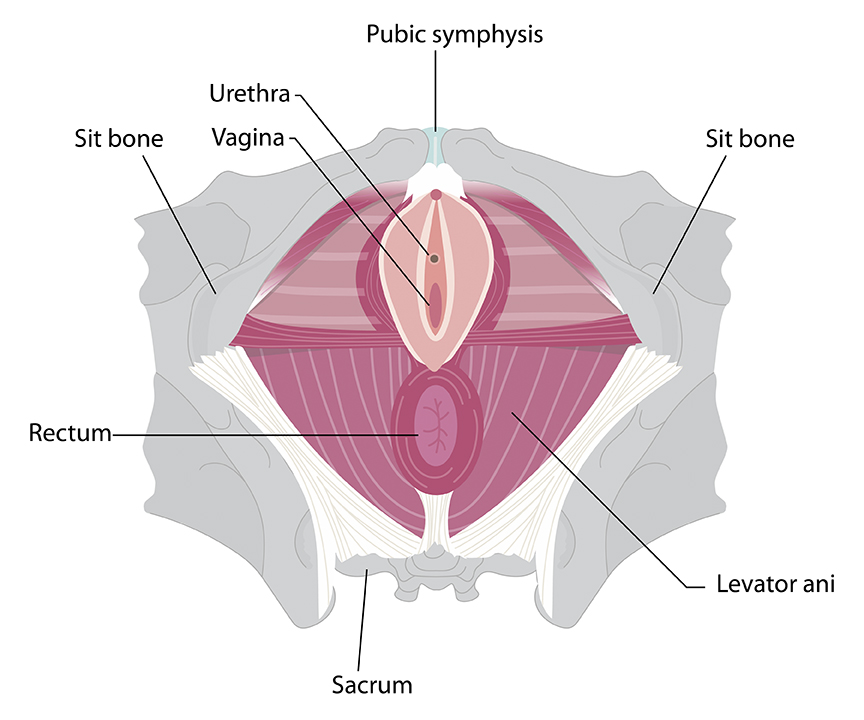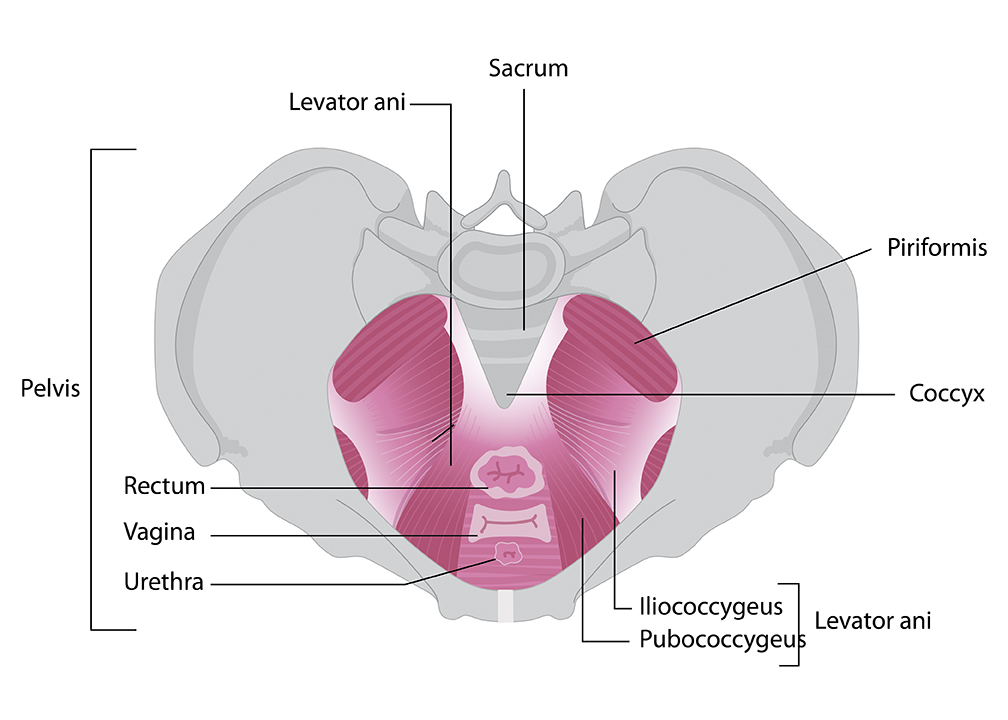What is the pelvic floor anyway?
There is a lot of talk about the pelvic floor and the importance of it during pregnancy and postpartum. But what is it and why is it so important?
What is the Pelvic Floor?
The pelvic floor is a multilayer group of muscles, ligaments, fascia and organs that line the bottom of the pelvic cavity. It attaches from the pubic bone (front) to the tailbone (back) and from each sit bone (sides), like a hammock.The center of the pelvic floor is the perineum, between the vulva and anus, which is the connection point to many muscles and ligaments.
The Pelvic Floor Muscles, Ligaments and Fascia
There are three layers of muscles within the pelvic floor. Each has a different role to play [which we’ll get to later]. The most superficial layer is just underneath the labia. And the deep layer surrounds the urethra, vagina and rectum like a figure eight then fans out to the boney pelvis. The second layer is sandwiched between these two layers.
Connecting the pelvic organs to the boney pelvis are ligaments (picture tethers to a tent). And surrounding the pelvis joints are ligaments.
Woven into the muscle and around the organs is fascia, a fiborous tissue that provides structure integrity [think of the “pulp” or fibers in oranges].
The Pelvic Floor Organs
The bladder, reproductive organs and rectum (or colon) are the pelvic organs. Just behind the pubic bone sits the bladder and from it the urethra descends through the pelvic floor tissues. Behind the bladder are the reproductive organs (RO), which are the uterus, the fallopian tubes, ovaries. From the uterus the vagina descends through the pelvic floor tissue to the vulva or opening. And after the RO is the colon, descending through the pelvic floor tissues and ending at the anus.
The Pelvic Floor Muscles, Ligaments & Fascias Role
The pelvic floor muscles have several distinctive roles:
Keep the pelvic organs in place and functioning within the pelvis
Close the urethra to keep pee in and open the urethra to let pee out
Close the anal sphincter to keep gas and stool in and open to let it out
Sexual appreciation
Posture
The pelvic floor muscles are part of the deep core unit that works together to keep you upright.
Movement and stability of the pelvis joints
The pelvis takes a lot of forces from below through the legs and above from the spine. The muscles help the joints manage these forces.
Balance intraabdominal pressure
The pelvic floor closes the bottom of the trunk cavity, which is pressurized, so we can breath. The muscles assist in keeping the pressure balanced.
Gut health
Working together with the deep core unit the pelvic floor muscles make sure the intestines have proper cushion for digestion.
The ligaments and fascia of the pelvic floor work with the muscles to make sure the pelvic organs and joints are in place and structurally strong.
The functions of the pelvic organs
The bladder is the urine storage for the body. It constantly fills as the kidneys filter blood of toxins and waste product. Once the bladder is filled to a certain point it will signal the body to empty. To urinate the body relaxes the pelvic floor muscles to open the urethra and contracts the bladder [which is totally involuntary].
The reproductive organs are for sex and having a baby. The ovaries and uterus control hormone regulation. The uterus is the vessel for fetal development, and some believe a women’s core or center. During sex and birth the pelvic floor muscles relax to make space around the vagina and vulva. The superficial layers of the pelvic floor make up the clitoris and thus the G-spot. So until birth, these muscles will then contract for orgasm. During birth the uterus contracts the push baby through the cervix, vagina and vulva while the pelvic floor muscles remain relaxes and lengthened.
The rectum (or colon) is the last portion of the intestines and the end of digestive tract. It is there your body is signaled that stool is ready to be passed. It will, however continue to absorb water from the stool until your have a bowel movement. Again, this signal will set into motion an involuntary relaxation of the pelvic floor to open the anal sphincter.
Both the bladder and bowel can be controlled voluntarily when you are not in a place to pee or poop or fart, by contracting the pelvic floor muscles.
Influences on the Pelvic Floor
As you now know the role of the pelvic floor is crucial for keeping from peeing or pooping your pants, supporting pregnancy and birth, an enjoyable sexual experience and structural integrity of your bones for posture and movement.
These roles can be influenced however by many factors such as: posture, chronic coughing, heavy lifting, prolonged standing, previous injuries, bladder and bowel habits, activity choices, constipation/gut health, pregnancy, birth experience/trauma, and genetics. Paying attention to these factors in your life and being proactive to optimize pelvic health will not only benefit your in the short term for conception, pregnancy, birth and postpartum. But in the long term for overall well being.
If you want to learn more about how you can improve your pelvic floor health for conception through postpartum, set up a complimentary consult call with me, expectingpelvichealth.com/strategycall!




